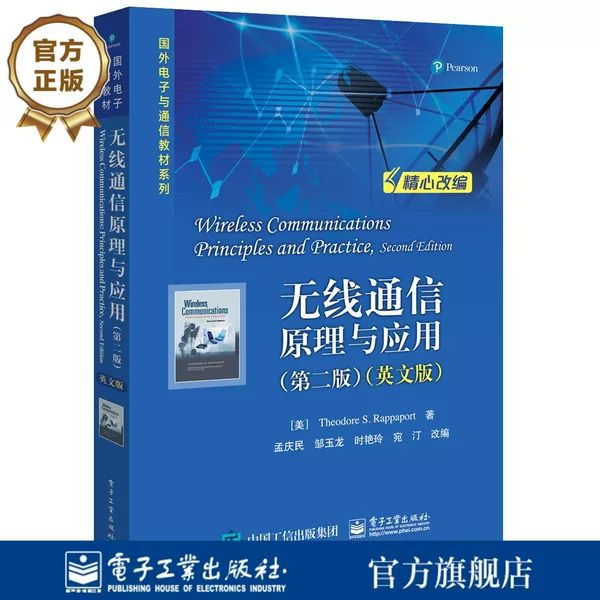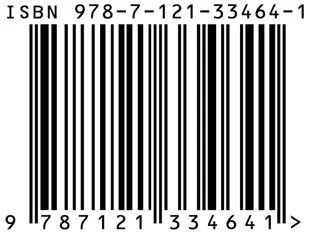
无线通信原理与应用 第二版 无线通信课程专业教材书籍 无线通信技术与系统设计 无线通信系统书英文版 国外电子与通信教材系列
Посилання на оригінал- 100 — 1999 шт 5000$ за шт.
- 2000 — 50119 шт 4000$ за шт.
- 50120+ шт 3000$ за шт.
Перевірка + фотозвіт за 1.5$
Ми перевіряємо товар та робимо фотозвіт, щоб ви могли переконатися, що отримаєте потрібний товар без браку та пошкоджень.
Доставка з Китаю в Україну, Узбекистан, країни Європи.
Сплачується після прибуття на склад у Китаї
Повернення товару можливе лише поки товар знаходиться у нас на складі в Китаї. Після відправки з Китаю товар поверненню не підлягає.
Фото та опис товару



|
||||||||||||||||||||||||||||||||||||||||||||||||||||||||||||||||||||||||||||||||||||

Chapter 1 Introduction to Wireless Communication Systems
无线通信系统概述
1.1?Evolution of Mobile Radio Communications
移动无线通信的发展
1.2?Mobile Radiotelephony in the U.S.
美国移动无线电话
1.3?Mobile Radio Systems Around the World
全球移动通信系统
1.4?Examples of Wireless Communication Systems
无线通信系统的实例
1.4.1?Paging Systems
1.4.2?Cordless Telephone Systems
1.4.3?Cellular Telephone Systems
1.4.4 Comparison of Common Wireless Communication Systems
1.5 Trends in Cellular Radio and Personal Communications
蜂窝无线通信和个人通信的发展趋势
1.6 Problems
习题
Chapter 2 Modern Wireless Communication Systems
现代无线通信系统
2.1 Second Generation (2G) Cellular Networks
2G蜂窝网络
2.1.1 Evolution to 2.5G Mobile Radio Networks
2.1.2 Evolution for 2.5G TDMA Standards
2.1.3 IS-95B for 2.5G CDMA
2.2 Third Generation (3G) Wireless Networks
3G无线网络
2.2.1 3G W-CDMA (UMTS)
2.2.2 3G cdma2000
2.2.3 3G TD-SCDMA
2.3 Wireless Local Loop (WLL) and LMDS
无线本地环路(WLL)与LMDS
2.4 Wireless Local Area Networks (WLANs)
无线局域网(WLAN)
2.5 Bluetooth and Personal Area Networks (PANs)
蓝牙和个域网(PAN)
2.6 Summary
小结
2.7 Problems
习题
Chapter 3 The Cellular Concept—System Design Fundamentals
蜂窝的概念:系统设计基础
3.1 Introduction
概述
3.2 Frequency Reuse
频率复用
3.3 Channel Assignment Strategies
信道分配策略
3.4 Handoff Strategies
切换策略
3.4.1 Prioritizing Handoffs
3.4.2 Practical Handoff Considerations
3.5 Interference and System Capacity
干扰和系统容量
3.5.1 Co-channel Interference and System Capacity
3.5.2 Channel Planning for Wireless Systems
3.5.3 Adjacent Channel Interference
3.5.4 Power Control for Reducing Interference
3.6 Trunking and Grade of Service
中继和服务等级
3.7 Improving Coverage and Capacity in Cellular Systems
提高蜂窝系统容量
3.7.1 Cell Splitting
3.7.2 Sectoring
3.7.3 Repeaters for Range Extension
3.7.4 A Microcell Zone Concept
3.8 Summary
小结
3.9 Problems
习题
Chapter 4 Mobile Radio Propagation: Large-Scale Path Loss
移动无线电传播:大尺度路径损耗
4.1 Introduction to Radio Wave Propagation
无线电波传播介绍
4.2 Free Space Propagation Model
自由空间传播模型
4.3 Relating Power to Electric Field
电场和功率
4.4 The Three Basic Propagation Mechanisms
三种基本传播机制
4.5 Reflection
反射
4.5.1 Reflection from Dielectrics
4.5.2 Brewster Angle
4.5.3 Reflection from Perfect Conductors
4.6 Ground Reflection (Two-Ray) Model
地面反射(双线)模型
4.7 Diffraction
绕射
4.7.1 Fresnel Zone Geometry
4.7.2 Knife-edge Diffraction Model
4.7.3 Multiple Knife-edge Diffraction
4.8 Scattering
散射
4.8.1 Radar Cross Section Model
4.9 Practical Link Budget Design Using Path Loss Models
运用路径损耗模型进行实际的链路预算设计
4.9.1 Log-distance Path Loss Model
4.9.2 Log-normal Shadowing
4.9.3 Determination of Percentage of Coverage Area
4.10?Outdoor Propagation Models
室外传播模型
4.10.1 Longley–Rice Model
4.10.2 Durkin’s Model—A Case Study
4.10.3 Okumura Model
4.10.4 Hata Model
4.10.5 PCS Extension to Hata Model
4.10.6 Walfisch and Bertoni Model
4.10.7 Wideband PCS Microcell Model
4.11?Indoor Propagation Models
室内传播模型
4.11.1 Partition Losses (same floor)
4.11.2 Partition Losses between Floors
4.11.3 Log-distance Path Loss Model
4.11.4 Ericsson Multiple Breakpoint Model
4.11.5 Attenuation Factor Model
4.12?Signal Penetration into Buildings
建筑物信号穿透
4.13?Ray Tracing and Site Specific Modeling
射线跟踪和特定站址建模
4.14?Problems
习题
Chapter 5 Mobile Radio Propagation: Small-Scale Fading and Multipath
移动无线电传播:小尺度衰落和多径效应
5.1 Small-Scale Multipath Propagation
小尺度多径传播
5.1.1 Factors Influencing Small-Scale Fading
5.1.2 Doppler Shift
5.2 Impulse Response Model of a Multipath Channel
多径信道的冲激响应模型
5.2.1 Relationship Between Bandwidth and Received Power
5.3 Small-Scale Multipath Measurements
小尺度多径测量
5.3.1 Direct RF Pulse System
5.3.2 Spread Spectrum Sliding Correlator Channel Sounding
5.3.3 Frequency Domain Channel Sounding
5.4 Parameters of Mobile Multipath Channels
移动多径信道的参数
5.4.1 Time Dispersion Parameters
5.4.2 Coherence Bandwidth
5.4.3 Doppler Spread and Coherence Time
5.5 Types of Small-Scale Fading
小尺度衰落类型
5.5.1 Fading Effects Due to Multipath Time Delay Spread
5.5.2 Fading Effects Due to Doppler Spread
5.6 Rayleigh and Ricean Distributions
瑞利和莱斯分布
5.6.1 Rayleigh Fading Distribution
5.6.2 Ricean Fading Distribution
5.7 Statistical Models for Multipath Fading Channels
多径衰落信道的统计模型
5.7.1 Clarke’s Model for Flat Fading
5.7.2 Simulation of Clarke and Gans Fading Model
5.7.3 Level Crossing and Fading Statistics
5.7.4 Two-ray Rayleigh Fading Model
5.7.5 Saleh and Valenzuela Indoor Statistical Model
5.7.6 SIRCIM and SMRCIM Indoor and Outdoor Statistical Models
5.8 Theory of Multipath Shape Factors for Small-Scale Fading Wireless Channels
小尺度衰落无线信道的多径成型因子理论
5.8.1 Introduction to Shape Factors
5.8.2 Examples of Fading Behavior
5.8.3 Second-Order Statistics Using Shape Factors
5.8.4 Applying Shape Factors to Wideband Channels
5.8.5 Revisiting Classical Channel Models with Shape Factors
5.9 Summary
小结
5.10?Problems
习题
Chapter 6 Modulation Techniques and an Overview of Equalization, Diversity
移动无线电中的调制技术
6.1 Frequency Modulation vs. Amplitude Modulation
调频与调幅
6.2 Amplitude Modulation
幅度调制
6.2.1 Single Sideband AM
6.2.2 Pilot Tone SSB
6.2.3 Demodulation of AM Signals
6.3 Angle Modulation
角度调制
6.3.1 Spectra and Bandwidth of FM Signals
6.3.2 FM Modulation Methods
6.3.3 FM Detection Techniques
6.3.4 Tradeoff Between SNR and Bandwidth in an FM Signal
6.4 Digital Modulation—an Overview
数字调制概述
6.4.1 Factors That Influence the Choice of Digital Modulation
6.4.2 Bandwidth and Power Spectral Density of Digital Signals
6.5 Line Coding
波形编码
6.6 Pulse Shaping Techniques
脉冲成形技术
6.6.1 Nyquist Criterion for ISI Cancellation
6.6.2 Raised Cosine Rolloff Filter
6.6.3 Gaussian Pulse-Shaping Filter
6.7 Geometric Representation of Modulation Signals
调制信号的几何表示
6.8 Linear Modulation Techniques
线性调制技术
6.8.1 Binary Phase Shift Keying (BPSK)
6.8.2 Differential Phase Shift Keying (DPSK)
6.8.3 Quadrature Phase Shift Keying (QPSK)
6.8.4 QPSK Transmission and Detection Techniques
6.8.5 Offset QPSK
6.8.6 π/4 QPSK
6.8.7 π/4 QPSK Transmission Techniques
6.8.8 π/4 QPSK Detection Techniques
6.9 Constant Envelope Modulation
恒包络调制
6.9.1 Binary Frequency Shift Keying
6.9.2 Minimum Shift Keying (MSK)
6.9.3 Gaussian Minimum Shift Keying (GMSK)
6.10?Combined Linear and Constant Envelope Modulation Techniques
线性和恒包络组合调制技术
6.10.1 M-ary Phase Shift Keying (MPSK)
6.10.2 M-ary Quadrature Amplitude Modulation (QAM)
6.10.3 M-ary Frequency Shift Keying (MFSK) and OFDM
6.11?Spread Spectrum Modulation Techniques
扩频调制技术
6.11.1 Pseudo-Noise (PN) Sequences
6.11.2 Direct Sequence Spread Spectrum (DS–SS)
6.11.3 Frequency Hopped Spread Spectrum (FH–SS)
6.11.4 Performance of Direct Sequence Spread Spectrum
6.11.5 Performance of Frequency Hopping Spread Spectrum
6.12?Modulation Performance in Fading and Multipath Channels
衰落和多径信道中的调制性能
6.12.1 Performance of Digital Modulation in Slow Flat-Fading Channels
6.12.2 Digital Modulation in Frequency Selective Mobile Channels
6.12.3 Performance of π/4 DQPSK in Fading and Interference
6.13?An Overview of Equalization, Diversity
关于均衡与分集的概述
6.13.1 Introduction
6.13.2 Fundamentals of Equalization
6.13.3 Diversity Techniques
6.13.4 RAKE Receiver
6.13.5 Fundamentals of Channel Coding
6.14?Problems
习题
Chapter 7 Multiple Access Techniques for Wireless Communications
无线通信多址接入技术
7.1 Introduction
概述
7.1.1 Introduction to Multiple Access
7.2 Frequency Division Multiple Access (FDMA)
频分多址(FDMA)
7.3 Time Division Multiple Access (TDMA)
时分多址(TDMA)
7.4 Spread Spectrum Multiple Access
扩频多址(SSMA)
7.4.1 Frequency Hopped Multiple Access (FHMA)
7.4.2 Code Division Multiple Access (CDMA)
7.4.3 Hybrid Spread Spectrum Techniques
7.5 Space Division Multiple Access (SDMA)
空分多址(SDMA)
7.6 Packet Radio
分组无线电(PR)
7.6.1 Packet Radio Protocols
7.6.2 Carrier Sense Multiple Access (CSMA) Protocols
7.6.3 Reservation Protocols
7.6.4 Capture Effect in Packet Radio
7.7 Capacity of Cellular Systems
蜂窝系统的容量
7.7.1 Capacity of Cellular CDMA
7.7.2 Capacity of CDMA with Multiple Cells
7.7.3 Capacity of Space Division Multiple Access
7.8 Problems
习题
Chapter 8 Wireless Networking
无线网络
8.1 Introduction to Wireless Networks
概述
8.2 Differences Between Wireless and Fixed Telephone Networks
无线网络和固定电话网的区别
8.2.1 The Public Switched Telephone Network (PSTN)
8.2.2 Limitations in Wireless Networking
8.2.3 Merging Wireless Networks and the PSTN
8.3 Development of Wireless Networks
无线网络的发展
8.3.1 First Generation Wireless Networks
8.3.2 Second Generation Wireless Networks
8.3.3 Third Generation Wireless Networks
8.4 Fixed Network Transmission Hierarchy
固定网络传输层次
8.5 Traffic Routing in Wireless Networks
无线网络中的业务路由
8.5.1 Circuit Switching
8.5.2 Packet Switching
8.5.3 The X.25 Protocol
8.6 Wireless Data Services
无线数据业务
8.6.1 Cellular Digital Packet Data (CDPD)
8.6.2 Advanced Radio Data Information Systems (ARDIS)
8.6.3 RAM Mobile Data (RMD)
8.7 Common Channel Signaling (CCS)
公共信道信令(CCS)
8.7.1 The Distributed Central Switching Office for CCS
8.8 Integrated Services Digital Network (ISDN)
综合业务数字网(ISDN)
8.8.1 Broadband ISDN and ATM
8.9 Signaling System No. 7 (SS7)
7号信令系统(SS7)
8.9.1 Network Services Part (NSP) of SS7
8.9.2 The SS7 User Part
8.9.3 Signaling Traffic in SS7
8.9.4 SS7 Services
8.9.5 Performance of SS7
8.10?An Example of SS7 — Global Cellular Network Interoperability
SS7的一个实例:全球蜂窝网络互操作性
8.11?Personal Communication Services/Networks (PCS/PCNs)
个人通信业务与个人通信网(PCS/PCN)
8.11.1?Packet vs. Circuit Switching for PCN
8.11.2?Cellular Packet-Switched Architecture
8.12?Protocols for Network Access
网络接入的协议
8.12.1?Packet Reservation Multiple Access (PRMA)
8.13?Network Databases
网络数据库
8.13.1?Distributed Database for Mobility Management
8.14?Universal Mobile Telecommunication System (UMTS)
通用移动通信系统(UMTS)
8.15?Summary
小结
Appendix A Trunking Theory
中继理论
Appendix B Noise Figure Calculationsfor Link Budgets
链路预算中的噪声系数计算
Appendix C Q, erf & erfc Functions
Q、erf?和erfc函数
Appendix D Mathematical Tables, Functions, and Transforms
数学公式表、函数与变换
Appendix E Abbreviations and Acronyms
缩略词
Appendix F References
参考文献

本书是无线通信课程的权威教材,面向那些已经熟悉诸如概率论、通信原理和基本电磁学等技术概念的学生与工程师。全书深入浅出地讨论了无线通信技术与系统设计方面的内容,包括无线网络涉及的所有基本问题,特别是3G系统和无线局域网的问题,并对无线网络技术进展和全球主要的无线通信标准给出了论述。全书共分8章,集中讲述了蜂窝的概念、移动无线电传播、调制技术、多址技术等,结合理论对无线通信系统的各个方面做了精辟论述和统计分析。

Theodore S.Rappaport:得克萨斯大学电子工程系教授,Prentice Hall通信工程与新兴技术系列丛书主编,1990年成立移动与便携无线电研究小组。

本书适合作为通信工程与电子信息类相关专业高年级本科生和研究生的双语教学教材,对有一定通信理论基础的工程技术人员也有很好的参考价值。
 South Africa
South Africa
 Nigeria
Nigeria

































